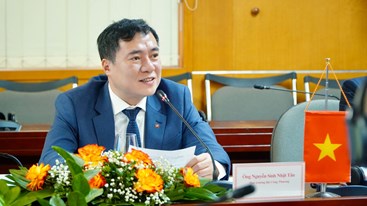Friday, 19/04/2024 | 08:12 GMT+7
Some young fellows stare at a big TV screen and shout
noisily as they are watching a World Cup 2010 football match. Some electric
fans run at their maximal speed to soothe the ongoing summer heat. The pigsty
system behind the house of Tran Van Tam in Phu Trung hamlet, An Phu commune, Cu
Chi district,
Power cuts no longer a concern
Calling on the house of Tran Van Tam in An Phu commune, Cu Chi district, Ho Chi Minh City, I was so surprised when the house owner opened the refrigerator to take out a bottle of water, then he poured the cool water onto a glass and gave me. He also asked his son to turn on another electric fan. Before going there I was told that the area suffered from power cuts around the clock. To my surprise, Tam turned on several other bulbs and said gladly “I do not care if the power is out all month.” I ran my eyes over the room to find a petrol-driven power generator. Catching my intention, Tam said “Our countryside residents do not have much money to buy such a costly machine. We use home-made ones.”

With backward outlook, a biogas power generator of Hai Mun
is very useful in hot summer days
Tam led me to the house back to see his special home-made power generator. Amazingly, the machine looked very obsolete with a mass of cords and strings. The machine input was a big plastic pipe like the one connected to a gas tank, and the output was some big electric wires.
Tam said his home-made power generator could produce up to 10kW so that he used big electric wires for power transmission to run a pumping machine, a TV set, a refrigerator, some fans and lamps. However, the most important part of the home-made power generator was a plastic pipe whose one end links to the generator and another end to a pig droppings tank.
When I once again came into his house and enjoyed the comfort given by power equipment, Tam described me carefully about his special power generator. The generator ‘petrol tank’ was a big crater that was in a garden in the house back. The pig droppings from the nearby pigsty system were poured into the crater.
To create biogas, Tam covered the crater with a big plastic sheet. A plastic pipe is used to procure home-made biogas from the crater to operate the power generator. Thus, when the residents in diverse areas suffer from frequent power outages, the family of Tam can use their ‘home-made’ power to operate electric equipment.
To help other people, Tam shares his power to nearby families who can also run TV sets, electric fans, bulbs, and pumping machines without connecting to the national power grid. Tam said he could save around VND3 million each month compared to using state network power. He told me that in the coming period he could raise more pigs to increase the power capacity to 15-20kW. By that time, he hopes he could share more power to neighboring families.
In a proximity to Tam house is a big building of Nguyen Thi Thao that is also lit with lamps when the area suffers from a power cut. Apart from running common electric wares such as fans, lamps, a TV set and a washing machine Thao operates an air conditioner in her bedroom and welding machines in her family’s mechanical enterprise. All the power comes from a home-made power generator using biogas procured from a pig droppings tank.
Diverse families in hamlet 5, Tan Thanh Dong commune, Cu Chi
district (
Leaving Cu Chi, I came to other locations and saw that a lot of farmers were running power generators with biogas taken from animal droppings tanks to replace using power from the national power grid. Nguyen Van Duc, a farmer in Doan Ket hamlet, Giang Dien commune, Trang Bom district, Dong Nai province said that he used home-made power for more than a decade. His 7.5kW power generator could run around the clock using biogas from a 1,000-head pigsty system. Besides serving the pigsty and household needs, he had enough power to operate the husking and animal feed plants. “The best thing is that I can manage the power source but not relying on the state network power,” he confined.
A ‘unique’ invention
Recalling the time her husband, Phong, engaged in studying ways to produce a biogas power generator, Nguyen Thi Thao said happily “At first, many people fiercely criticized my husband’s work. They said it was a waste of time to compete with engineers in manufacturing such a power machine. However, my husband was consistent with his work and got success. When his biogas power generators run effectively, the people that formerly laughed on him come back to ask his techniques on producing the power machine.”

In days when his area is prone to power cuts, Tran Van Tam can watch football matches on TV with his home-made power generator
Telling his story, Tran Van Tam said it took him around a year to mull over the idea of manufacturing a biogas power generator. At first, he used animal droppings to create biogas for cooking. Later, he thought of burning biogas to operate power generators. He spent much time on discovering ways to use animal droppings to create biogas for running power generators. His constant efforts were duly rewarded and he could consequently manufacture two power generators (7.5kW and 10kW) of this kind.
Tam said that the technology on manufacture biogas power generators was now commonplace in many rural areas. Animal droppings are the main energy source to run biogas power generators. A herd of at least 30 heads of pigs or cattle can produce enough biogas to run small power generators. Big pigsty farms with several hundred to several thousand heads can operate 10-50kW power generators.
Alongside serving their family electrical needs, these capable farmers also sell their home-made power generators to customers when there are orders. Tran Van Tam sold around 30 his power generators to people in diverse areas. Some power generators have capacity reaching 20kW that is sufficient to provide power to a small village. The cost of these machines ranges from VND10-20 million and they can be used for many years with careful maintenances.
Nguyen Van Duc in Dong Nai province sold out nearly 70
home-made power generators. The largest capacity power generator he produces
was 60kW that could light a whole hamlet when this area suffers from power
outages. Especially, he used to design some small water-powered electrical
generators also.
“The uplanders often do small-scale livestock breeding that cannot produce enough biogas to operate power generators. Therefore, using water to operate power generators is a viable solution in highland areas,” Duc said. The power is low in capacity in areas with small streams; however, it is sufficient to light several bulbs and small TV sets to meet the uplander entertainment needs.
.png?w=367&h=206&mode=crop)






.jpg?w=367&h=206&mode=crop)
.jpg?w=367&h=206&mode=crop) Energy efficiency and conservation usage is an important aspect of the national energy development strategy
Energy efficiency and conservation usage is an important aspect of the national energy development strategy
 Challenges and Opportunities to promote energy efficiency market in Vietnam
Challenges and Opportunities to promote energy efficiency market in Vietnam
 The Ministry of Industry and Trade requests government agencies to coordinate in organizing Earth Hour 2024
The Ministry of Industry and Trade requests government agencies to coordinate in organizing Earth Hour 2024
 Consultation on Energy Efficiency Boiler Catalogue and Wood Drying Guideline
Consultation on Energy Efficiency Boiler Catalogue and Wood Drying Guideline
 Son Ha Co., Ltd, applies energy efficiency and conservation measures
Son Ha Co., Ltd, applies energy efficiency and conservation measures
 Phuc Kien Co., Ltd., is effectively implementing energy-saving measures
Phuc Kien Co., Ltd., is effectively implementing energy-saving measures
.png?w=367&h=206&mode=crop) Request for expression of interest - C2.1.13: Capacity Building on energy efficiency policies development
Request for expression of interest - C2.1.13: Capacity Building on energy efficiency policies development